Microstructure and Wear Resistance of Laser-Treated and Slow Cooled AlSi10Mg-(x)Ni Alloys
Abstract
1. Introduction
2. Materials and Methods
3. Results and Discussions
3.1. Sample Solidification Data: DS and LSR
3.2. Wear and Damage Analysis
4. Conclusions
- The DS samples consisted of an α-Al dendrite matrix and eutectic mixture in the interdendritic regions (coarse Si + Al3Ni particles).
- The 1% Ni alloy exhibited growth of Al3Ni plates and blocks, alongside fishbone-like particles.
- The LSR treatment altered the microstructural configuration, forming very small cells (about 100 times smaller than DS dendritic arrays) encased in Si + Al3Ni skeletal arrangements, particularly at the top of the molten pool.
- Vickers hardness tended to increase with decreasing dendritic spacing.
- Short-term wear testing (10 min at 0.5 N) revealed that DS 1% Ni alloy samples had higher resistance due to the stability and compactness of the formed debris layer during wear.
- The LSR samples showed high wear resistance attributed to the high density of cell boundaries acting as a barrier to plastic deformation and preventing cracks in the subsurface regions.
- The wear resistance of the LSR samples appeared to be somewhat independent of Ni content and hardness variations.
Author Contributions
Funding
Acknowledgments
Conflicts of Interest
References
- Yang, J.; Xiao, M.; Wu, L.; Li, Z.; Liu, H.; Zhao, Y.; Guo, W.; Tan, C. The influence of laser power on microstructure and properties of laser welding-brazing of Al alloys to Al-Si coated 22MnB5 steel. Opt. Laser Technol. 2023, 162, 109318. [Google Scholar] [CrossRef]
- Dash, S.S.; Chen, D. A Review on Processing–Microstructure–Property Relationships of Al-Si Alloys: Recent Advances in Deformation Behavior. Metals 2023, 13, 609. [Google Scholar] [CrossRef]
- Hu, Z.; Huo, Q.; Chen, Y.; Liu, M.; Chen, X. Improving Mechanical Property of Hyper-Eutectic Al-Si Alloys via Regulating the Microstructure by Rheo-Die-Casting. Metals 2023, 13, 968. [Google Scholar] [CrossRef]
- Abdellah, M.Y.; Fadhl, B.M.; Abu El-Ainin, H.M.; Hassan, M.K.; Backar, A.H.; Mohamed, A.F. Experimental Evaluation of Mechanical and Tribological Properties of Segregated Al-Mg-Si Alloy Filled with Alumina and Silicon Carbide through Different Types of Casting Molds. Metals 2023, 13, 316. [Google Scholar] [CrossRef]
- Zhang, Z.; Liu, M.Y.; Breton, F.; Chen, X.G. Microstructure and Mechanical Properties of AlSi10Mg Permanent Mould and High Pressure Vacuum Die Castings. In Proceedings of the 16th International Aluminum Alloys Conference (ICAA16), Montreal, QC, Canada, 17–21 June 2018; pp. 17–21. [Google Scholar]
- Fite, J.; Prameela, S.E.; Slotwinski, J.; Weihs, T.P. Enhanced mechanical properties by eutectic cells in AlSi10Mg—A promising paradigm for strengthening aluminum in additive manufacturing. Mater. Charact. 2023, 204, 113179. [Google Scholar] [CrossRef]
- Moura, D.A.; Gouveia, G.L.; Gomes, L.F.; Spinelli, J.E. Understanding the effect of Ni content on microstructures and tensile properties of AlSi10Mg alloy samples under a variety of solidification rates. J. Alloys Compd. 2022, 924, 166496. [Google Scholar] [CrossRef]
- Yan, Q.; Song, B.; Shi, Y. Comparative Study of Performance Comparison of AlSi10Mg Alloy Prepared by Selective Laser Melting and Casting. J. Mater. Sci. Technol. 2020, 41, 199–208. [Google Scholar] [CrossRef]
- Yang, C.-Y.; Lee, S.-L.; Lee, C.-K.; Lin, J.-C. Effects of Sr and Sb Modifiers on the Sliding Wear Behavior of A357 Alloy under Varying Pressure and Speed Conditions. Wear 2006, 261, 1348–1358. [Google Scholar] [CrossRef]
- Tavitas-Medrano, F.J.; Gruzleski, J.E.; Samuel, F.H.; Valtierra, S.; Doty, H.W. Effect of Mg and Sr-Modification on the Mechanical Properties of 319-Type Aluminum Cast Alloys Subjected to Artificial Aging. Mater. Sci. Eng. A 2008, 480, 356–364. [Google Scholar] [CrossRef]
- Abouei, V.; Shabestari, S.G.; Saghafian, H. Dry Sliding Wear Behaviour of Hypereutectic Al–Si Piston Alloys Containing Iron-Rich Intermetallics. Mater. Charact. 2010, 61, 1089–1096. [Google Scholar] [CrossRef]
- Zykova, A.; Martyushev, N.; Skeeba, V.; Zadkov, D.; Kuzkin, A. Influence of W Addition on Microstructure and Mechanical Properties of Al-12%Si Alloys. Materials 2019, 12, 981. [Google Scholar] [CrossRef] [PubMed]
- Li, Q.; Xia, T.; Lan, Y.; Zhao, W.; Fan, L.; Li, P. Effect of in Situ γ-Al2O3 Particles on the Microstructure of Hypereutectic Al–20%Si Alloy. J. Alloys Compd. 2013, 577, 232–236. [Google Scholar] [CrossRef]
- Li, Y.; Yang, Y.; Wu, Y.; Wei, Z.; Liu, X. Supportive Strengthening Role of Cr-Rich Phase on Al–Si Multicomponent Piston Alloy at Elevated Temperature. Mater. Sci. Eng. A 2011, 528, 4427–4430. [Google Scholar] [CrossRef]
- Shaha, S.K.; Czerwinski, F.; Kasprzak, W.; Friedman, J.; Chen, D.L. Thermal Stability of (AlSi) (ZrVTi) Intermetallic Phases in the Al–Si–Cu–Mg Cast Alloy with Additions of Ti, V, and Zr. Thermochim. Acta 2014, 595, 11–16. [Google Scholar] [CrossRef]
- Feng, J.; Ye, B.; Zuo, L.; Qi, R.; Wang, Q.; Jiang, H.; Huang, R.; Ding, W. Effects of Ni Content on Low Cycle Fatigue and Mechanical Properties of Al-12Si-0.9Cu-0.8Mg-XNi at 350 °C. Mater. Sci. Eng. A 2017, 706, 27–37. [Google Scholar] [CrossRef]
- Li, Y.; Yang, Y.; Wu, Y.; Wang, L.; Liu, X. Quantitative Comparison of Three Ni-Containing Phases to the Elevated-Temperature Properties of Al–Si Piston Alloys. Mater. Sci. Eng. A 2010, 527, 7132–7137. [Google Scholar] [CrossRef]
- Farkoosh, A.R.; Javidani, M.; Hoseini, M.; Larouche, D.; Pekguleryuz, M. Phase Formation in As-Solidified and Heat-Treated Al–Si–Cu–Mg–Ni Alloys: Thermodynamic Assessment and Experimental Investigation for Alloy Design. J. Alloys Compd. 2013, 551, 596–606. [Google Scholar] [CrossRef]
- Zhuang, Y.X.; Zhang, X.M.; Zhu, L.H.; Hu, Z.Q. Eutectic Spacing and Faults of Directionally Solidified Al–Al3 Ni Eutectic. Sci. Technol. Adv. Mater. 2001, 2, 37–39. [Google Scholar] [CrossRef]
- Hunt, W.H., Jr. New Directions in Aluminum-Based P/M Materials for Automotive Applications. SAE Trans. 2000, 109, 90–97. [Google Scholar]
- Rakhmonov, J.; Liu, K.; Pan, L.; Breton, F.; Chen, X.-G. Enhanced Mechanical Properties of High-Temperature-Resistant Al–Cu Cast Alloy by Microalloying with Mg. J. Alloys Compd. 2020, 827, 154305. [Google Scholar] [CrossRef]
- Manohara, H.R.; Chandrashekharaiah, T.M.; Venkateswarlu, K.; Kori, S.A. Dry Sliding Wear Response of A413 Alloy: Influence of Intermetallics and Test Parameters. Tribol. Int. 2012, 51, 54–60. [Google Scholar] [CrossRef]
- Miranda, G.; Buciumeanu, M.; Carvalho, O.; Soares, D.; Silva, F.S. Interface Analysis and Wear Behavior of Ni Particulate Reinforced Aluminum–Silicon Composites Produced by PM. Compos. Part B Eng. 2015, 69, 101–110. [Google Scholar] [CrossRef]
- Savaşkan, T.; Alemdağ, Y. Effect of Nickel Additions on the Mechanical and Sliding Wear Properties of Al–40Zn–3Cu Alloy. Wear 2010, 268, 565–570. [Google Scholar] [CrossRef]
- Liu, Y.; Jia, L.; Wang, W.; Jin, Z.; Zhang, H. Effects of Ni Content on Microstructure and Wear Behavior of Al–13Si–3Cu–1Mg-XNi–0.6Fe–0.6Mn Alloys. Wear 2022, 500–501, 204365. [Google Scholar] [CrossRef]
- Mirzaee-Moghadam, M.; Lashgari, H.R.; Zangeneh, S.; Rasaee, S.; Seyfor, M.; Asnavandi, M.; Mojtahedi, M. Dry Sliding Wear Characteristics, Corrosion Behavior, and Hot Deformation Properties of Eutectic Al–Si Piston Alloy Containing Ni-Rich Intermetallic Compounds. Mater. Chem. Phys. 2022, 279, 125758. [Google Scholar] [CrossRef]
- Xavier, M.G.C.; Freitas, B.J.M.; Koga, G.Y.; Spinelli, J.E. Effects of Ni and Co on the Corrosion Resistance of Al-Si-Cu-Zn-Fe Alloys in NaCl Solution. Metals 2022, 12, 645. [Google Scholar] [CrossRef]
- Freitas, E.S.; Silva, A.P.; Spinelli, J.E.; Casteletti, L.C.; Garcia, A. Inter-Relation of Microstructural Features and Dry Sliding Wear Behavior of Monotectic Al–Bi and Al–Pb Alloys. Tribol. Lett. 2014, 55, 111–120. [Google Scholar] [CrossRef]
- Silva, A.S.; de Albuquerque Sousa, S.M.; de Gouveia, G.L.; Garcia, A.; Spinelli, J.E. The influence of NbB inoculation on dendritic spacing and grain size of an aluminum 2017 alloy at different cooling rates. Int. J. Adv. Manuf. Technol. 2023, 125, 5681–5696. [Google Scholar] [CrossRef]
- Cruz, K.S.; Meza, E.S.; Fernandes, F.A.P.; Quaresma, J.M.V.; Casteletti, L.C.; Garcia, A. Dendritic Arm Spacing Affecting Mechanical Properties and Wear Behavior of Al-Sn and Al-Si Alloys Directionally Solidified under Unsteady-State Conditions. Metall. Mater. Trans. A 2010, 41, 972–984. [Google Scholar] [CrossRef]
- Savaşkan, T.; Bican, O. Dry Sliding Friction and Wear Properties of Al–25Zn–3Cu–3Si Alloy. Tribol. Int. 2010, 43, 1346–1352. [Google Scholar] [CrossRef]
- Dong, Y.J.; Wang, H.M. Microstructure and Dry Sliding Wear Resistance of Laser Clad TiC Reinforced Ti–Ni–Si Intermetallic Composite Coating. Surf. Coat. Technol. 2009, 204, 731–735. [Google Scholar] [CrossRef]
- Gündüz, M.; Çadırlı, E. Directional Solidification of Aluminium–Copper Alloys. Mater. Sci. Eng. A 2002, 327, 167–185. [Google Scholar] [CrossRef]
- Valenzuela Reyes, R.A.; Garcia, A.; Spinelli, J.E. Evaluating Microstructure, Wear Resistance and Tensile Properties of Al-Bi(-Cu, -Zn) Alloys for Lightweight Sliding Bearings. Metals 2021, 11, 153. [Google Scholar] [CrossRef]
- Brito, C.; Costa, T.A.; Vida, T.A.; Bertelli, F.; Cheung, N.; Spinelli, J.E.; Garcia, A. Characterization of Dendritic Microstructure, Intermetallic Phases, and Hardness of Directionally Solidified Al-Mg and Al-Mg-Si Alloys. Metall. Mater. Trans. A 2015, 46, 3342–3355. [Google Scholar] [CrossRef]
- Kakitani, R.; Cruz, C.B.; Lima, T.S.; Brito, C.; Garcia, A.; Cheung, N. Transient Directional Solidification of a Eutectic Al–Si–Ni Alloy: Macrostructure, Microstructure, Dendritic Growth and Hardness. Materialia 2019, 7, 100358. [Google Scholar] [CrossRef]
- Liu, Y.J.; Liu, Z.; Jiang, Y.; Wang, G.W.; Yang, Y.; Zhang, L.C. Gradient in Microstructure and Mechanical Property of Selective Laser Melted AlSi10Mg. J. Alloys Compd. 2018, 735, 1414–1421. [Google Scholar] [CrossRef]
- Kurz, W.; Fisher, D. Fundamentals of Solidification, 4th ed.; Trans Tech Publications: Zurich, Switzerland, 1998. [Google Scholar]
- Reddy, A.S.; Bai, B.N.P.; Murthy, K.S.S.; Biswas, S.K. Wear and Seizure of Binary Al Si Alloys. Wear 1994, 171, 115–127. [Google Scholar] [CrossRef]
- Razavizadeh, K.; Eyre, T.S. Oxidative Wear of Aluminium Alloys. Wear 1982, 79, 325–333. [Google Scholar] [CrossRef]
- Razavizadeh, K.; Eyre, T.S. Oxidative Wear of Aluminium Alloys: Part II. Wear 1983, 87, 261–271. [Google Scholar] [CrossRef]
- Antoniou, R.; Borland, D.W. Mild Wear of AlSi Binary Alloys during Unlubricated Sliding. Mater. Sci. Eng. 1987, 93, 57–72. [Google Scholar] [CrossRef]
- Spinelli, J.E.; Silva, B.L.; Garcia, A. Assessment of Tertiary Dendritic Growth and Its Effects on Mechanical Properties of Directionally Solidified Sn-0.7Cu-XAg Solder Alloys. J. Electron. Mater. 2014, 43, 1347–1361. [Google Scholar] [CrossRef]
- Gill, S.C.; Zimmermann, M.; Kurz, W. Laser Resolidification of the AlAl2Cu Eutectic: The Coupled Zone. Acta Metall. Mater. 1992, 40, 2895–2906. [Google Scholar] [CrossRef]
- Pinto, M.A.; Cheung, N.; Ierardi, M.C.F.; Garcia, A. Microstructural and Hardness Investigation of an Aluminum–Copper Alloy Processed by Laser Surface Melting. Mater. Charact. 2003, 50, 249–253. [Google Scholar] [CrossRef]
- Yao, Z.; Ren, W.; Allison, J. Microstructure and Microsegregation Characterization of Laser Surfaced Remelted Al-3wt%Cu Alloys. Res. Sq. 2021. preprint. [Google Scholar] [CrossRef]
- Wang, J.; Wang, H.; Gao, H.; Yang, J.; Zhang, M.; Cheng, X.; Zhang, S.; Liu, D. Crystal Growth for Different Substrate Orientations during Laser Directed Solidification of Single Crystal Superalloys. J. Alloys Compd. 2023, 957, 170219. [Google Scholar] [CrossRef]
- Zhou, X.; Chao, P.; Sloan, L.; Lien, H.; Hunter, A.H.; Misra, A.; Shahani, A.J. Three-dimensional morphology of an ultrafine Al-Si eutectic produced via laser rapid solidification. Scr. Mater. 2023, 232, 115471. [Google Scholar] [CrossRef]
- Spinelli, J.E.; Bogno, A.-A.; Henein, H. Two-Zone Microstructures in Al-18Si Alloy Powders. Metall. Mater. Trans. A 2018, 49, 550–562. [Google Scholar] [CrossRef]
- Canté, M.V.; Spinelli, J.E.; Ferreira, I.L.; Cheung, N.; Garcia, A. Microstructural Development in Al-Ni Alloys Directionally Solidified under Unsteady-State Conditions. Metall. Mater. Trans. A 2008, 39, 1712–1726. [Google Scholar] [CrossRef]
- Stadler, F.; Antrekowitsch, H.; Fragner, W.; Kaufmann, H.; Uggowitzer, P.J. The Effect of Ni on the High-Temperature Strength of Al-Si Cast Alloys. Mater. Sci. Forum 2011, 690, 274–277. [Google Scholar] [CrossRef]
- Xiong, Z.H.; Liu, S.L.; Li, S.F.; Shi, Y.; Yang, Y.F.; Misra, R.D.K. Role of Melt Pool Boundary Condition in Determining the Mechanical Properties of Selective Laser Melting AlSi10Mg Alloy. Mater. Sci. Eng. A 2019, 740–741, 148–156. [Google Scholar] [CrossRef]
- Rathod, H.J.; Nagaraju, T.; Prashanth, K.G.; Ramamurty, U. Tribological Properties of Selective Laser Melted Al 12Si Alloy. Tribol. Int. 2019, 137, 94–101. [Google Scholar] [CrossRef]
- Thasleem, P.; Kuriachen, B.; Kumar, D.; Ahmed, A.; Joy, M.L. Effect of Heat Treatment and Electric Discharge Alloying on the Tribological Performance of Selective Laser Melted AlSi10Mg. J. Tribol. 2021, 143, 2100147. [Google Scholar] [CrossRef]
- Mishra, A.K.; Upadhyay, R.K.; Kumar, A. Surface Wear Anisotropy in AlSi10Mg Alloy Sample Fabricated by Selective Laser Melting: Effect of Hatch Style, Scan Rotation and Use of Fresh and Recycled Powder. J. Tribol. 2021, 143, 021701. [Google Scholar] [CrossRef]
- Tonolini, P.; Montesano, L.; Tocci, M.; Pola, A.; Gelfi, M. Wear Behavior of AlSi10Mg Alloy Produced by Laser-Based Powder Bed Fusion and Gravity Casting. Adv. Eng. Mater. 2021, 23, 2100147. [Google Scholar] [CrossRef]

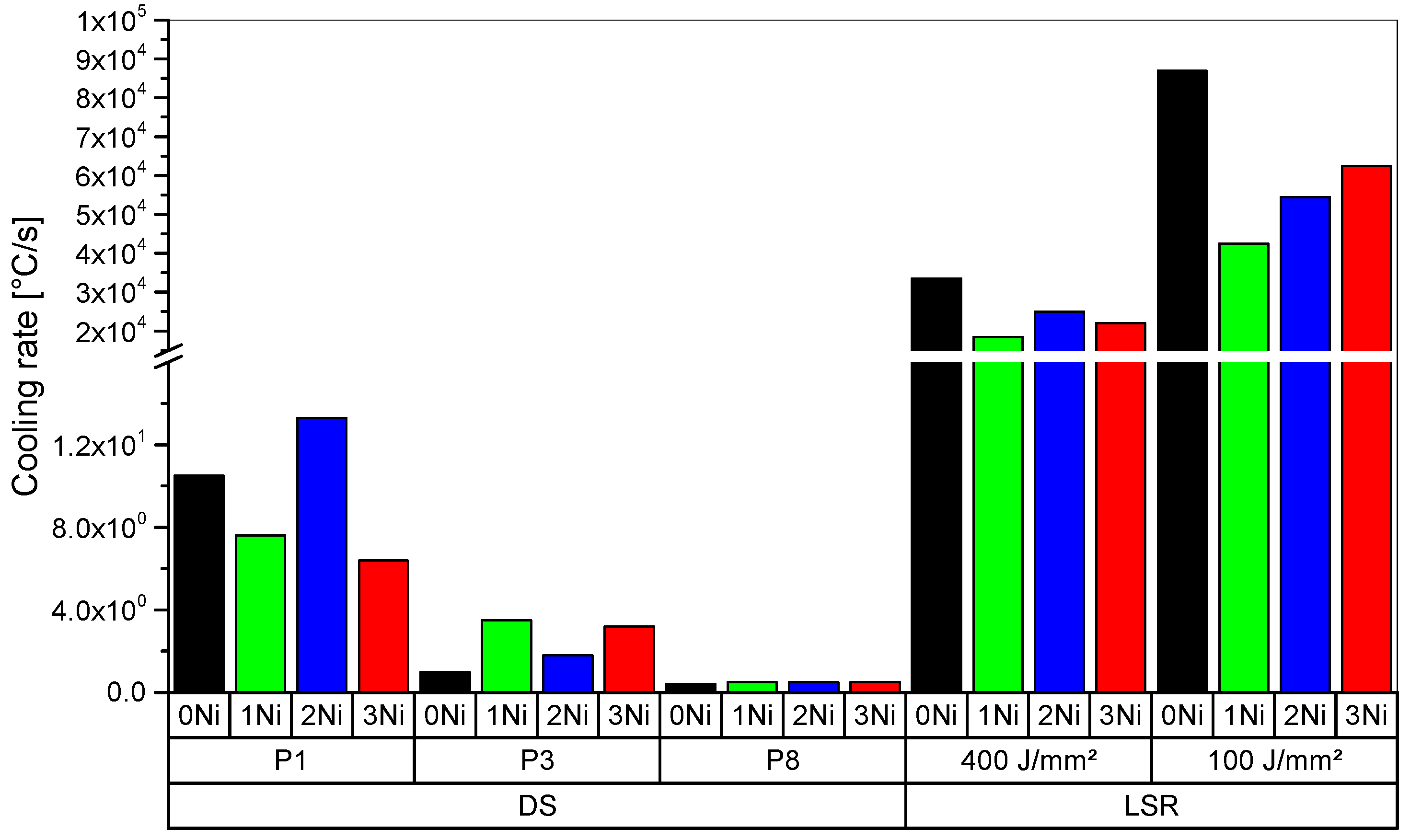

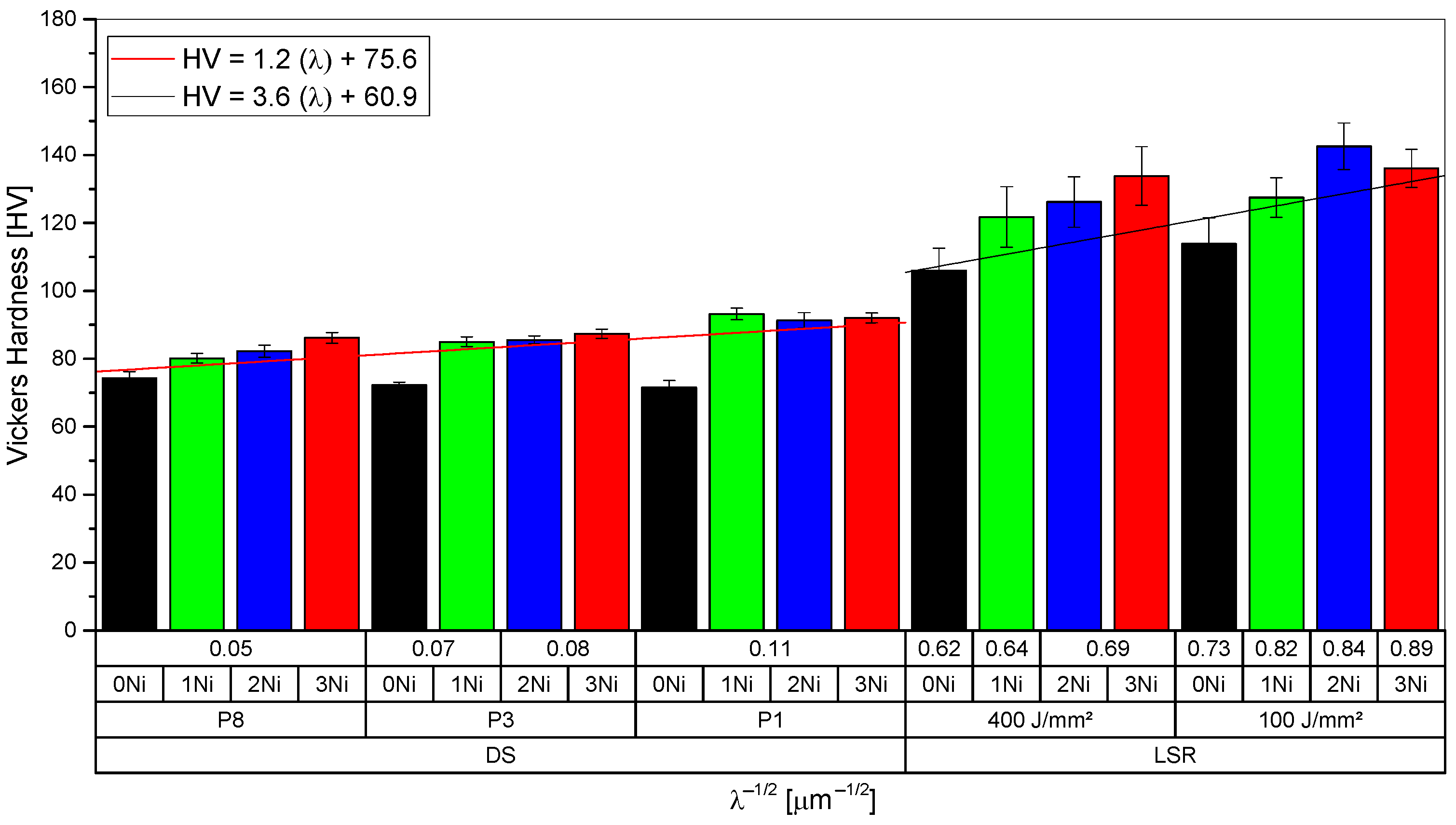
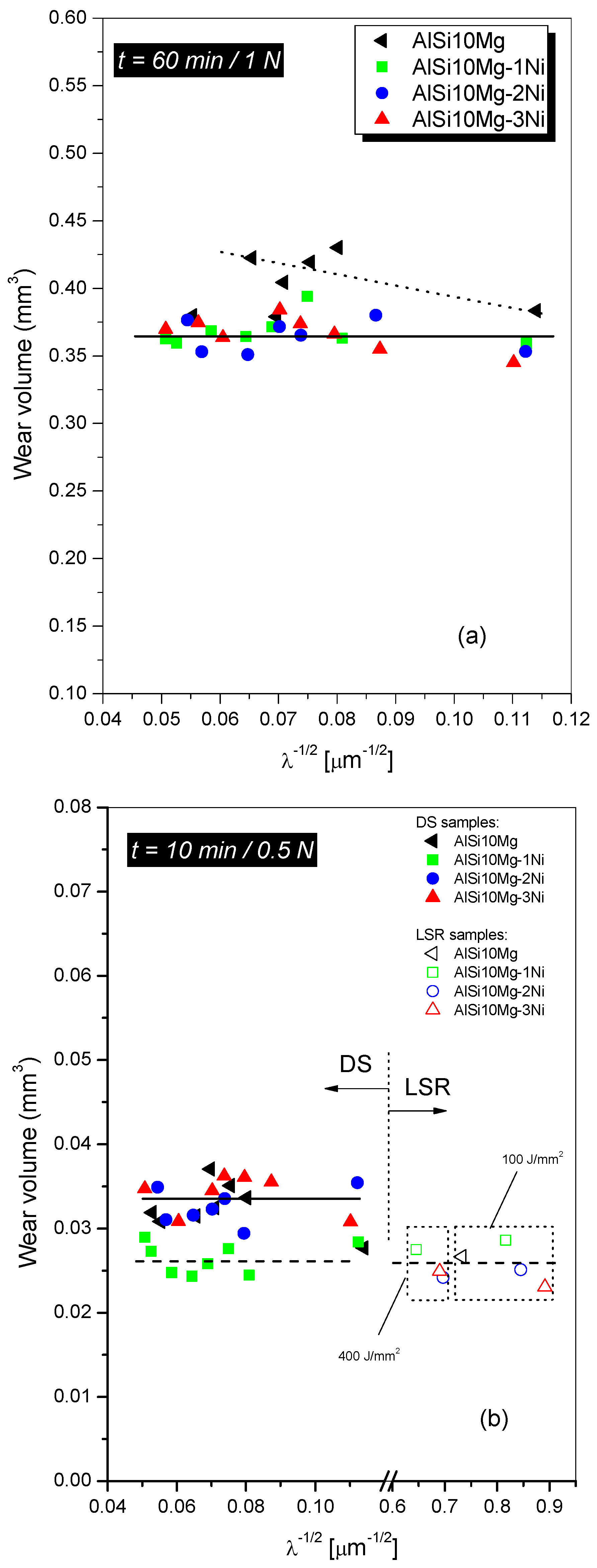

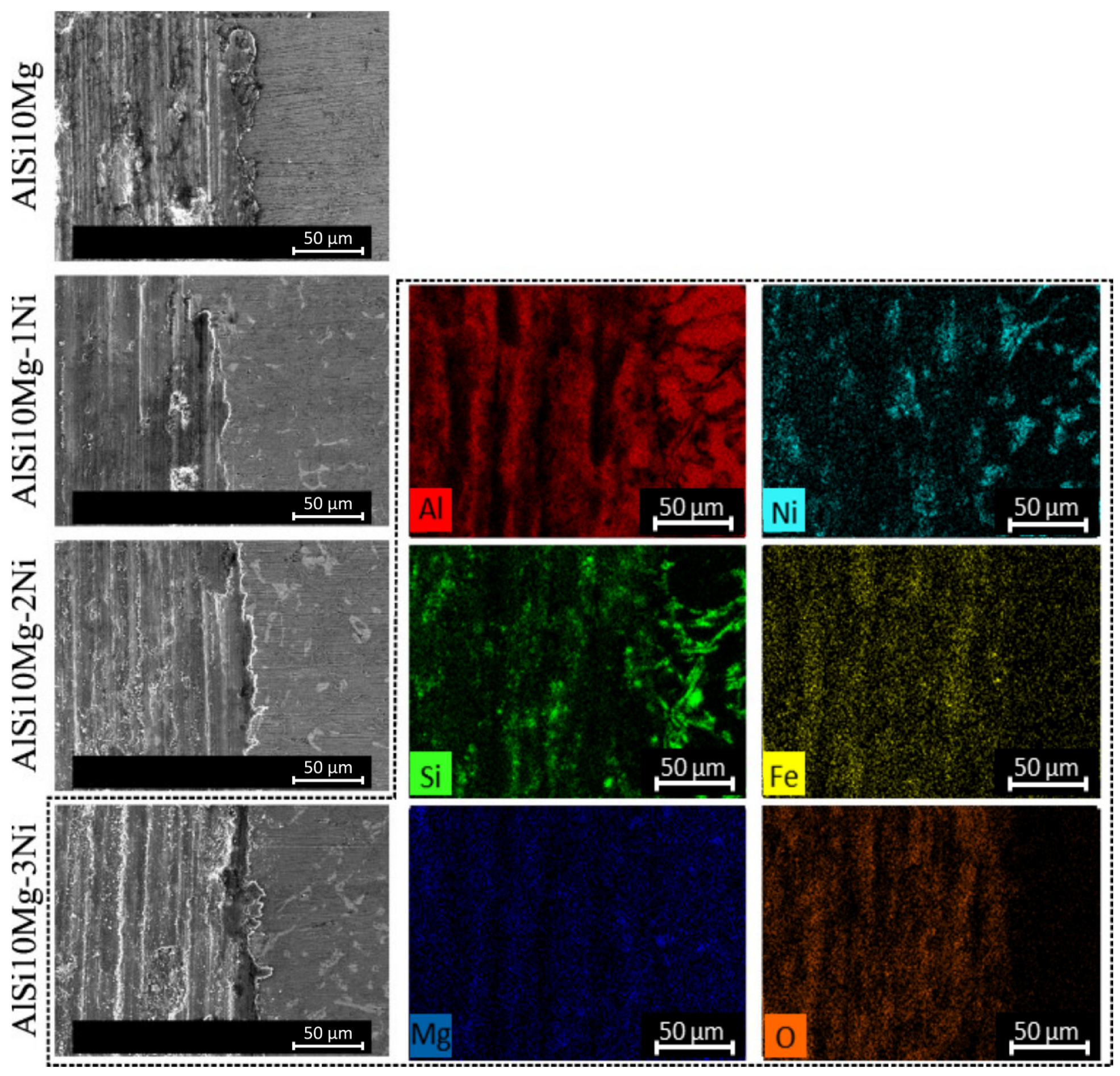

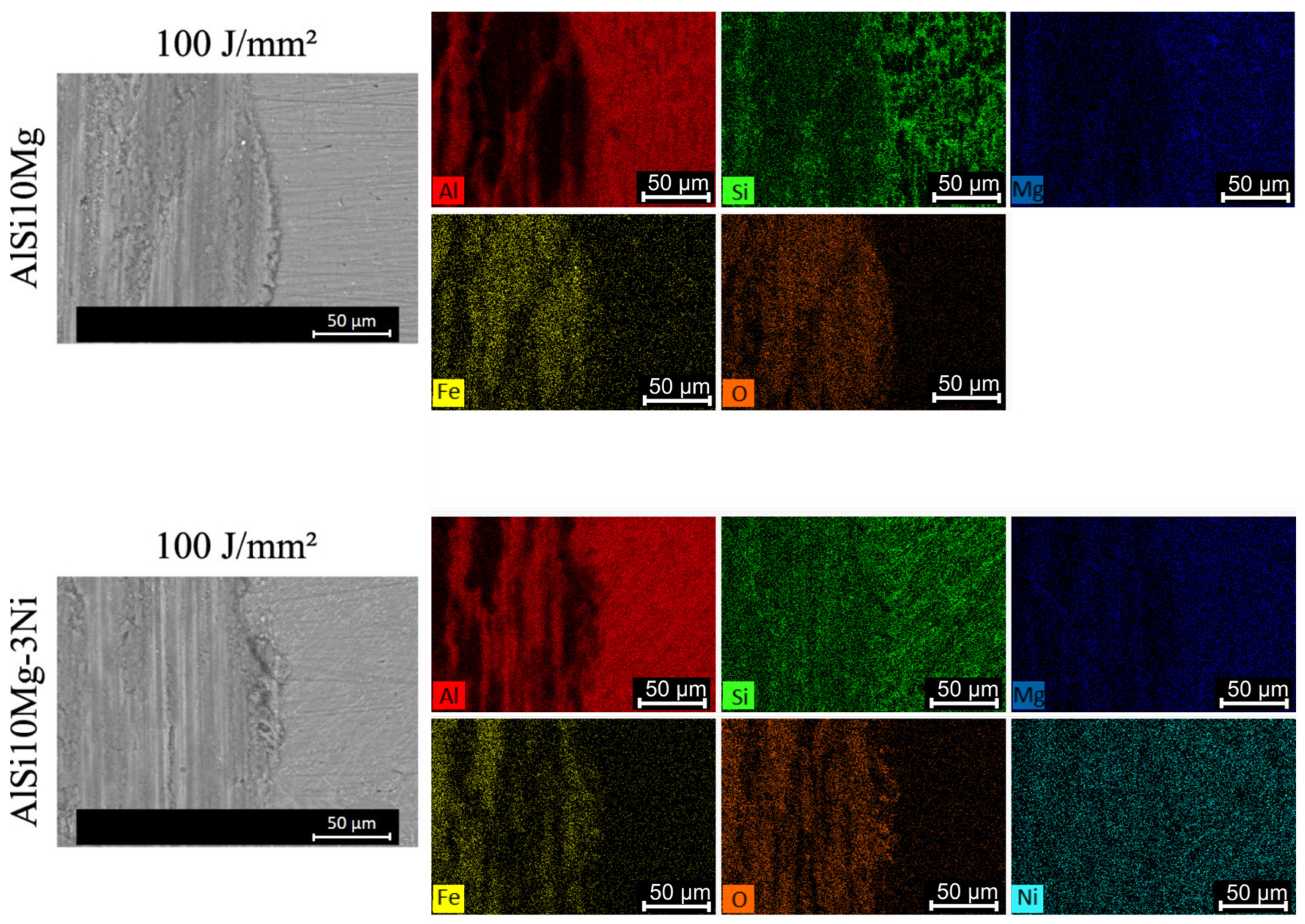
Disclaimer/Publisher’s Note: The statements, opinions and data contained in all publications are solely those of the individual author(s) and contributor(s) and not of MDPI and/or the editor(s). MDPI and/or the editor(s) disclaim responsibility for any injury to people or property resulting from any ideas, methods, instructions or products referred to in the content. |
© 2023 by the authors. Licensee MDPI, Basel, Switzerland. This article is an open access article distributed under the terms and conditions of the Creative Commons Attribution (CC BY) license (https://creativecommons.org/licenses/by/4.0/).
Share and Cite
Moura, D.; Gouveia, G.; Spinelli, J. Microstructure and Wear Resistance of Laser-Treated and Slow Cooled AlSi10Mg-(x)Ni Alloys. Metals 2023, 13, 1426. https://doi.org/10.3390/met13081426
Moura D, Gouveia G, Spinelli J. Microstructure and Wear Resistance of Laser-Treated and Slow Cooled AlSi10Mg-(x)Ni Alloys. Metals. 2023; 13(8):1426. https://doi.org/10.3390/met13081426
Chicago/Turabian StyleMoura, Danusa, Guilherme Gouveia, and José Spinelli. 2023. "Microstructure and Wear Resistance of Laser-Treated and Slow Cooled AlSi10Mg-(x)Ni Alloys" Metals 13, no. 8: 1426. https://doi.org/10.3390/met13081426
APA StyleMoura, D., Gouveia, G., & Spinelli, J. (2023). Microstructure and Wear Resistance of Laser-Treated and Slow Cooled AlSi10Mg-(x)Ni Alloys. Metals, 13(8), 1426. https://doi.org/10.3390/met13081426






